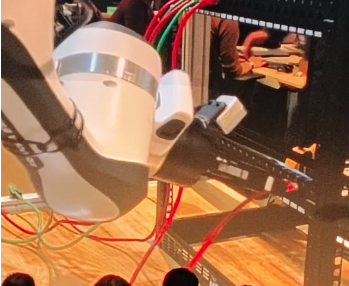Convincing Your Boss: How to Make a Business Case for Automation

Posted on Nov 22, 2022 in Automation
6 min read time
Do you want your company to adopt robots to improve your job? This may be a good idea… but only if you can convince your boss that automation is the way to go.
Like any business, your company has certain goals it must meet to be successful. These might be to reduce costs, to increase sales, or to improve the quality of your products.
Many companies – including the case study examples we introduce in this article – now find that robotic automation is an effective way to achieve a range of business goals. Robots can help to solve specific business problems and offer various benefits at the same time.
You might be convinced that robots are a good idea…
But your boss might not be yet.
How can you make a business case for automation and convince your boss that it is the right solution for your business?
Here's a quick guide.
Are robots risky? Understanding your boss's perspective
While robots have been used for decades in mass production environments, they are only recently making their way into other companies. Industries that have traditionally shied away from robots – such as logistics, eCommerce, and small scale manufacturing – are now seeing the benefits of robotic technology.
For many companies, deploying robots can seem like a major investment. Even though this isn't always true, people think robots are expensive and, thus, risky.
As well as the cost, another perceived risk is the negative publicity around robotics. Management might hesitate to adopt a technology that could make their employees afraid for their job security.
When deployed successfully, robots can help boost productivity, lower costs, and improve customer and employee satisfaction. But it helps to understand why your boss might see robots as a risky investment.
How robot adoption could affect your company
If your company was to adopt robots today, there could be both favorable and unfavorable scenarios that could come out of that (at least in the mind of your boss).
To build a strong business case for robotics, it's a good idea to consider both potential outcomes so you can increase the chance of favorable outcomes.
Potential favorable outcomes from adding robots include:
-
Increased productivity.
-
Less downtime.
-
Lower production costs.
-
Better use of workforce.
Potential unfavorable outcomes might include:
-
Assumed high upfront investment.
-
Maintenance and upkeep costs.
-
Fear of job loss from employees.
With the right robotic solution, you can mitigate these potential unfavorable outcomes. But you need to understand the perceived downsides, as these often play a factor when a company resists automation.

What is the business case for automation?
In order to get your boss on board with the idea of integrating robots into your business, you'll need to make a strong business case for it.
A business case is where you outline the justification for your proposed robotic automation project. It could be a long, official document, or just a casual conversation in the corridor of your building.
A strong business case will include:
-
The business problem or opportunity that you are trying to address.
-
Your proposed robotic solution.
-
An analysis of the benefits and costs of implementing your solution.
Ultimately, your business case should provide a convincing argument for why robotic automation is the best way to achieve your company's desired objectives.
The most important factor when creating a business case for automation
Various factors can go into creating a solid business case for robotic automation. But most important is to explain the benefits in terms that are important to your boss personally.
This means understanding what motivates your boss. You need to know what business objectives they are trying to achieve personally.
Some managers will be motivated by cost savings. Others will be more interested in increasing sales or optimizing workforce management. It's important to tailor your business case to the specific motivations of your boss. This will improve your chances of them accepting your proposal.
For example, if your boss is motivated by cost savings, you could highlight how robotic automation can help optimize labor costs, reduce material costs, and save energy costs. Alternatively, if they are motivated by product quality gains, you could explain how automation can reduce non-compliance and reduce human error.
You can find more examples in our workbook How to Convince Your Boss to Go With Cobots.
3 examples of companies with successful robot adoption
One of the most powerful ways to convince your boss that robotics is a good idea is to show them evidence. That can mean showing them examples of companies that have successfully overcome their business problems with robots.
Here are 3 examples of companies from our case study library:
Usinatech
Usinatech is a Montreal-based manufacturer of critical drivetrain and transmission components, like gears and shafts.
Here's how they successfully implemented robotic automation:
-
Business problem: The growing labor shortage and need to stay competitive was putting a lot of pressure on their manufacturing processes.
-
Robotic solution: The team automated 3 CNC machines using the Robotiq Machine Tending Solution
-
Results: They have seen significant productivity gains, lower operating costs, and a reduced employee turnover rate.
WALT Machine Inc.
WALT Machine Inc. is a manufacturer in Mississippi, USA that makes precision aluminum parts for optical assemblies, amongst other manufacturing services.
Here's how they successfully implemented robotic automation:
-
Business problem: A huge increase in demand meant they couldn't keep up with production because of the difficulty of hiring new employees.
-
Robotic solution: Having successfully implemented robotic automation before, the team added machine tending robots to 3 of their CNC machines.
-
Results: They went from making between 1,000 and 2,000 parts at a time to making 45,000 to 50,000 at a time.
Alliora
Alliora is a French manufacturer that specializes in high-end packaging products for a wide range of industries, including cosmetics and champagne.
Here's how they successfully implemented robotic automation:
-
Business problem: As a seasonal business, they usually hired many temporary workers to handle high orders. Finding these workers was becoming increasingly difficult, and they needed to stabilize production.
-
Robotic solution: They implemented the Robotiq Palletizing Solution on their palletizing task.
-
Results: The production line now flows more smoothly and has reduced the physical strain on packaging workers, for which the employees are very grateful.
Get the workbook and convince your boss to choose robots
Making a business case for any new project can be difficult, but with robotic automation, it is very worthwhile.
By tailoring your business case to the specific motivations of your company and your boss, you can significantly increase the chance that they accept your proposal. Adding examples of companies that have succeeded before, like those in our case study library, can also help to reduce the perceived risk of the investment.
If you are looking for more information on how to make a solid business case for robotics, our workbook is a great place to start.
Download a copy here: How to Convince Your Boss to Go With Cobots
How receptive is your boss to the idea of using robots? Tell us in the comments below or join the discussion on LinkedIn, Twitter, Facebook, or the DoF professional robotics community.






Leave a comment